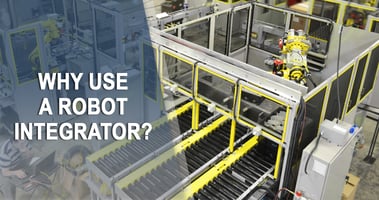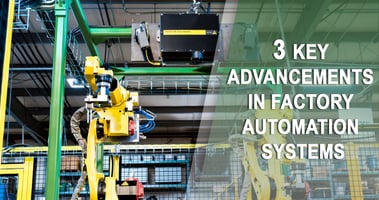Whether your goal is to reduce manpower, decrease waste, increase productivity, or achieve a higher...
How to Determine Whether Assembly Line Automation Is Right for Your Facility
.jpg?width=1684&name=Blog%20Post%2013%20-%20Banner%20Photo%20-%20FINAL%20(1).jpg)
There’s no shortage of options and technologies available for manufacturing companies to automate their assembly process. After all, automation has become a cornerstone of efficient, safe, and cost-effective production operations across a wide range of production industries and locations. For many organizations, the question is not whether the automation capabilities exist, but rather whether those assembly line solutions are uniquely suited to meet their underlying business objectives.
If your facility is considering the idea of integrating assembly line automation, you’re likely looking for some indication as to whether this decision is the right one for your business. It’s certainly true that automation has the potential to reap major advantages for manufacturing companies who wield it wisely. Even so, this decision-making process involves more than a basic understanding of possible benefits. It requires a nuanced approach to the investment and return realities associated with your particular operation.
The insights laid out in this article can help you develop a more informed perspective on whether your facility is a prime candidate for assembly line automation.
Advantages of Assembly Line Automation
Before jumping into the relationship between initial cost and long-term value, it’s important to get a clearer picture of the distinct outcomes often associated with automating one or more aspects of your assembly line. Whether you’re focusing on fixed or flexible automation solutions, here are some positive impacts to consider:
- Efficiency: Automation carries the unparalleled capacity to speed up assembly processes and decrease downtime. By integrating solutions that amplify production rates and minimize unexpected infringements on time, you can achieve higher levels of long-term profitability and competitiveness in the market.
- Consistency: An automated machine doesn’t tire or lose focus. A robot isn’t prone to getting distracted or forgetting a step in the process. And multitasking is far more effective when managed, even in part, by a programmable machine that lacks human constraints. That’s why automated solutions offer maximized repeatability and consistency in various assembly environments.
- Quality: With any assembly task that relies on human interaction, the potential for mistakes or lapses in quality exists. Of course, consumer trust and business profitability rely on an ability to minimize these defects. Automated assembly solutions have the power to make ultimate precision a reality, alleviating the risk to quality and accuracy as it pertains to the final product.
- Safety: Along assembly lines where heavy, expensive materials and equipment are handled by workers, there’s increased opportunity for human injury (not to mention product damage). Automated solutions for lifting, transporting or otherwise handling these pieces and parts can enable a facility to mitigate the risk of personal injury and liability.
- Cost Savings: In addition to the cost advantages inherent in faster, more consistent, higher-quality and safer operations, there’s also the fact that automation naturally minimizes the need for manpower, which cuts down on the major expense of labor in assembly functions. Depending on a number of factors, eliminating the cost of extra worker hours can reap significant savings for the organization and allow for a more competitive selling price.
Understanding the Challenge of ROI
Given the potential advantages of assembly line automation outlined above, there’s plenty of impetus to consider it a smart business strategy. However, the actual return to be reaped from an investment in automation technology and equipment—as well as the time it takes to be realized—is uniquely tied to each operation’s individual requirements and realities.
For a facility to automate its assembly line, it must evaluate the ROI implications. To do that, you must first identify and break down the cost of equipment needs.
It’s essential to understand, for example, the expense inherent in parts feeding. The separate parts requiring assembly must be transported to a central location. This means having a feed device to get the parts into the hands of the machine designed to assemble them.
So, let’s say that for a particular assembly line, the feed device runs an average cost of $20-50K. If there are ten different parts to assemble, the process may require an overall expenditure of approximately $200-500K on feeders.
Then there’s the expense of the machine needed to assemble those parts. If that machine runs in the range of $750K-$1M, the cost to build and integrate this automated solution could be higher than the cost to employ the original number of people necessary to assemble the parts manually for a couple years.
For some organizations, a multi-year payback period does not meet their budgetary restraints or business objectives. For others, the nature of their production line lends itself to automation solutions that can reap cost benefits more quickly. And sometimes, it's simply about balancing your options.
If, for instance, automating the parts feeding aspect of your assembly line does not produce an efficient ROI, it may be smarter to maintain workers for this function while implementing automation for the assembly tasks. Doing so could enable your facility to eliminate the capital expense of parts feeding machines while still reducing overall labor costs and maximizing the benefits of automation integration.
Asking the Important Questions
Because of the complexity involved in determining ROI in automated assembly line solutions, there’s no one-size-fits-all approach to the decision-making process. It’s paramount to understand your own business case before undertaking an integration project.
Some of the most fundamental questions required to get a clear picture and make an informed decision include:
- How many people are working the line currently?
- How many shifts are being run?
- What is the cost to employ those workers over that number of shifts?
- What number of workers would be acceptable?
- What would the overall cost of machine integration entail?
- How much savings would be gleaned from a reduction in workers?
- How much could potential throughput expand?
- What is a realistic payback period?
Again, the applications to automate your assembly line are out there. But it’s necessary to thoroughly answer questions like the aforementioned in order to make an ultimate determination as to whether those applications are best suited to your business needs.
One of the smartest ways to accomplish this is by partnering with an experienced integration expert dedicated to understanding your objectives and supporting your decision-making process. An automation integration specialist can provide critical insights and information regarding the potential ROI and related realities surrounding your project.
Learn more about the competitive advantages of manufacturing automation by downloading our whitepaper, "7 Ways Automation Makes Manufacturers More Competitive."



